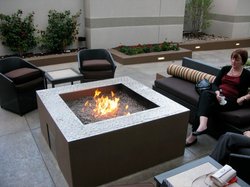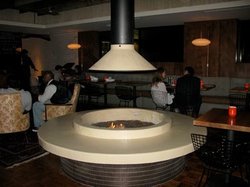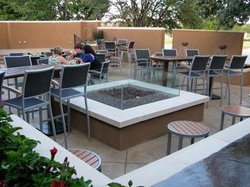 DALLAS — Man's fascination with fire goes back to prehistoric times, but we always find new ways to play with it. The latest toy: the fire pit, which has slunk from the backyard patio into fine-dining restaurants.
DALLAS — Man's fascination with fire goes back to prehistoric times, but we always find new ways to play with it. The latest toy: the fire pit, which has slunk from the backyard patio into fine-dining restaurants.In Dallas, you can find a grand circular pit greeting you at the entrance of Cedars Social, the new cocktail den from former New York Giants football player Brian Williams; an Olympian-flame version at Seasons 52, the new concept from Darden Restaurants; or a stunning iridescent mosaic cube on the patio at the Sheraton Dallas Hotel.
With its temperate climate, Dallas is an ideal fire pit location, and so is California; fire pits are also popular at resort destinations such as the Ritz Carlton in Vail, Colo. Not all cities allow them; some, like Atlanta, have fire code restrictions that make them difficult to build. The most famous fire-pit-in-a-restaurant is the one at Stefan's at The LA Farm, from Top Chef alum Stefan Richter; it has a cameo in the premiere of Season 7 ofEntourage.
Royce Ring, of Plan B Group in Dallas, which has designed fire pit concepts for clients such as Brickhouse Pub in Houston, Orlando, Fla., and Plainfield, N.J., credits the bad economy with lighting our fire for fire.
"Consumers are still eating out but it's for a social connection, and this is where the fire pit comes in," he says. "They're going out with their buddies, doing girls' night out, and fire pits make you feel good. You can sit or stand by them and it's a place to gather, to socialize, to have a drink."
Fire pits are also part of the trend of bringing the outdoors inside and vice versa, says Erin Spencer of Theme Designs, a Houston fire pit manufacturer. "As the outdoor movement influenced the inside, people began to develop their outdoor spaces," she says.
But restaurants have taken it to another level, says Jim Jarvis of Dancing Fire, a Weatherford fire pit manufacturer.
"Anyone can go down to Home Depot and get some bricks and you got a fire pit, but the ones you see in hotels and restaurants are made with top-of-the-line materials like marble, copper, and glass," he says.

Your fire pit basics are a box, ignition device, and burner. While they can provide some warmth, their purpose is mostly decorative. Anejo House of Tequila in North Richland Hills has a beveled-glass enclosure with a custom-made copper plume. The pit at Samar by Stephan Pyles combines fire with water, one of the two big trends in fire pits; the other is to have a fire pit right at your table, like the one fabricated for Stefan's at The LA Farm by California fire pit designer David Cooke.
"I think of it as, first we went from cavemen sitting around a campfire -- we put that function into a table, where you're able to dine and have your glass of wine, and still have that fire in front of you," Cooke says.

Not all diners have advanced from their caveman status: Unaware that fire pits are primarily decorative, some people toss items into the fire pit, mistaking it for a giant ashtray.
"It's an impulse," Jarvis says. "I've seen fire pits at beautiful resorts and they've got gum and cigarette butts."
Ring says that their appeal is about nostalgia.
"The first things that people remember about a fire could be a camping trip, or a fire on the beach at night, or a bonfire before the game," he says. "It goes back to when you're a kid. It's a reinforcement to a social connection with your friends that takes you back to a nice memory. Everybody loves being around a fire."


